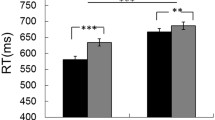Summary
Two-choice tactile RTs are no faster than 8-choice tasks, implying the existence of a ‘direct’ route. However, simple tactile RTs are much faster than choice tactile RTs (Leonard, 1959). In Experiment I we show that this is not due to subjects anticipating the stimulus in simple tactile RT tasks. Increasing probability of stimulus occurrence at a particular time led to equally decreased tactile RTs for simple and choice tasks.
We suggest that an alternative route is available for simple RTs which is faster than the ‘direct’ route available for choice tactile RTs. This route is faster because (a) the response can be specified in advance, and (b) the stimulus does not need to be identified. The subject needs merely to register that it has occurred. In Experiment II we show that simple RTs to a visual stimulus are decreased by a simultaneous uninformative tactile stimulus even when this is to the wrong finger. This confirms that exact stimulus identification is not necessary in the ‘fast’ route. In Experiment III we show that a secondary task slows down simple tactile RTs to the same level as choice tactile RTs while the latter are hardly affected. This suggests that focussed attention is not needed for the ‘direct’ route, but it is needed for the ‘fast’ route. We propose that a useful distinction can be made between action largely controlled by external stimuli (the ‘direct’ route) and action largely controlled by internal intentions of will (the fast route).
Similar content being viewed by others
References
Bloxham, C.A., Mindel, T.A, & Frith, C.D. (1984). Initiation and execution of predictable and unpredictable movements in Parkinson's disease. Brain, 107, 371–384.
Broadbent, D.E. (1958). Perception and Communication. Oxford: Pergamon Press.
Coltheart, M., Patterson, K., Marshall, J.C. (Eds.) (1980). Deep dyslexia. London: Routledge & Kegan Paul.
Denny-Brown, D. (1968). Clinical symptomatology of diseases of the basal ganglia. In Vinken, P.J. & Bruyn, G.W., (Eds.) Handbook of Clinical Neurology. Volume 6 (p. 136). Amsterdam: North-Holland.
Evarts, E.V., Teräväinen, H., & Calne, D.B. (1984). Reaction times in Parkinson's disease. Brain, 104, 167–186.
Fitts, P.M., Posner, M.I. (1973). Human Performance. London: Prentice/Hall.
Frith, C.D., Stevens, M., Johnstone, E.C., & Owens, D.G.C. (1984). The effects of chronic treatment with amitriptyline and diazepam on electrodermal activity in neurotic outpatients. Physiological Psychology, 12, 247–252.
Goodman, D., & Scott Kelso, J.A. (1980). Are movements prepared in parts? Not under compatible (naturalised) conditions. Journal of Experimental Psychology: General, 109, 475–495.
Hick, W.E. (1952). On the rate of gain of information. Ouarterly Journal of Experimental Psychology, 4, 11–26.
Kerr, B. (1978). Task factors that influence selection and preparation for voluntary movements. In G.E. Stelmach (Ed.) Information processing in motor control and learning. New York: Academic Press.
Klapp, S., Abbott, J., Coffman, K., Greim, D., Snider, R., & Young, F. (1979). Simple and choice reaction time methods in the study of motor programming. Journal of Motor Behaviour, 12, 91–101.
Leonard, J.A. (1958). Partial advance information in a choice reaction time task. British Journal of Psychology, 49, 89–96.
Leonard, J.A. (1959). Tactual choice reactions. Quarterly Journal of Experimental Psychology, 11, 76–83.
Martin, J.P. (1967). The basal ganglia and posture (pp. 33–35). London: Pitman Medical.
Megaw, E.D. (1972). Directional errors and their correction in a discrete tracking task. Ergonomics, 15, 633–643.
Mowbray, G.H., & Rhoades, M.U. (1959). On the reduction of choice reaction times with practice. Quarterly Journal of Experimental Psychology, 11, 16–23.
Rabbitt, P.M.A., Cumming, G., & Vyas, S. (1978). Some errors of perceptual analysis in visual search can be detected and corrected. Quarterly Journal of Experimental Psychology, 30, 319–332.
Rosenbaum, D.A. (1980). Human movement initiation. Specification of arm, direction and extent. Journal of Experimental Psychology: General, 109, 444–474.
Sternberg, S., Monsell, S., Knoll, R.L., & Wright, C.E. (1978). In G.E. Stelmach (Ed.) Information processing in motor control and learning. New York: Academic Press.
Wing, A.M., & Miller, E. (1984). Basal ganglia lesions and psychological analysis of voluntary movement control. In Functions of the basal ganglia. London: Pitman (Ciba Foundation Symposium 107).
Woodworth, R.S. (1938). Experimental Psychology, New York: Holt.
Zelaznik, H.N. (1978). Precueing response factors in choice reaction time. A word of caution. Journal of Motor Behaviour, 10, 77–80.
Author information
Authors and Affiliations
Rights and permissions
About this article
Cite this article
Frith, C.D., Done, D.J. Routes to action in reaction time tasks. Psychol. Res 48, 169–177 (1986). https://doi.org/10.1007/BF00309165
Received:
Issue Date:
DOI: https://doi.org/10.1007/BF00309165




